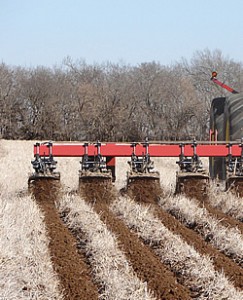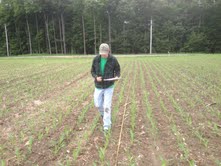 This past week I was introduced to the personal project I will be working on while with the Nutrient Management Spear Program. The project is evaluating the use and effect of various depths of zone tillage. But what exactly is zone tillage? In the world of tillage, there are generally two approaches: conventional and reduced/no-till systems. Conventional tillage systems would include the use of your typical moldboard plow, disk, chisel, aerway, etc. These methods generally create a quality seedbed while effectively incorporating organic matter, however also tend to have some negative effects on the soil with increased soil erosion, compaction, and decreased surface residues. Reduced/ no-till systems attempt to cause as little disruption to the soil as possible. Reduced/ no-till systems generally require specialized equipment such as a seed drill or zone tiller in order to not require conventional tillage to prepare a suitable seedbed. Zone tillage is where a narrow strip of soil is tilled, while leaving the areas between these strips undisturbed. This creates a quality seedbed (pictured), increases surface residue, reduces soil erosion and possibly relieves some compaction issues as well. This method essentially compromises on the positive effects and objectives of both conventional and no-till systems.
This past week I was introduced to the personal project I will be working on while with the Nutrient Management Spear Program. The project is evaluating the use and effect of various depths of zone tillage. But what exactly is zone tillage? In the world of tillage, there are generally two approaches: conventional and reduced/no-till systems. Conventional tillage systems would include the use of your typical moldboard plow, disk, chisel, aerway, etc. These methods generally create a quality seedbed while effectively incorporating organic matter, however also tend to have some negative effects on the soil with increased soil erosion, compaction, and decreased surface residues. Reduced/ no-till systems attempt to cause as little disruption to the soil as possible. Reduced/ no-till systems generally require specialized equipment such as a seed drill or zone tiller in order to not require conventional tillage to prepare a suitable seedbed. Zone tillage is where a narrow strip of soil is tilled, while leaving the areas between these strips undisturbed. This creates a quality seedbed (pictured), increases surface residue, reduces soil erosion and possibly relieves some compaction issues as well. This method essentially compromises on the positive effects and objectives of both conventional and no-till systems.
 For this study, I visited Table Rock Farm in Castile, NY. Data has been collected for several years at the farm looking at the possible effects of different depths of zone tillage. The three zone tillage depths in the study are zero (control – aerway), seven, and fourteen inches. This week, eight and twelve inch soil samples were taken to have soil test results prior to side dressing. In addition to soil samples, early season biomass plant samples, stand counts, plant height, and leaf counts were taken to be evaluated to see if there are any early significant differences between the depths.
For this study, I visited Table Rock Farm in Castile, NY. Data has been collected for several years at the farm looking at the possible effects of different depths of zone tillage. The three zone tillage depths in the study are zero (control – aerway), seven, and fourteen inches. This week, eight and twelve inch soil samples were taken to have soil test results prior to side dressing. In addition to soil samples, early season biomass plant samples, stand counts, plant height, and leaf counts were taken to be evaluated to see if there are any early significant differences between the depths.
 Currently, I am processing these samples and recording the results. The next data to be collected will be at the end of the season when the corn is being harvested to look at any possible yield differences.
Currently, I am processing these samples and recording the results. The next data to be collected will be at the end of the season when the corn is being harvested to look at any possible yield differences.

Speak Your Mind